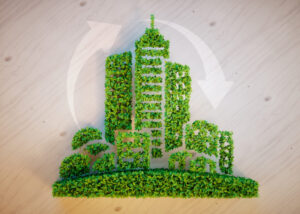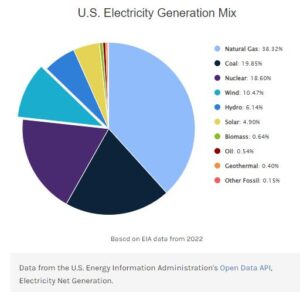In a previous blog, we delved into the importance of a circular economy, and how companies like eAsset Solutions long ago fully embraced its principles before the phrase took center stage. Today, we’ll explore the 7 best circular economy examples, go a little beyond our respective sphere of influence, and demonstrate why we believe the e-waste industry is and should be at the top of the list.
As a refresher, a circular economy is basically a sustainable model that cultivates responsible resource usage, aims to reduce waste, and preserve environmental resources. Spearheaded by legendary individuals like the architect and economist Walter R. Stahel, in collaboration with Genevieve Reday-Mulvey, the following are shining examples on industries fighting the good fight.
1. E-Waste Industry: The Original Circular Economy Champion
Enjoying a prominent place on our list, the e-waste industry rightly deserves to sit at number one as a circular economy example. A great one, at that. Dealing with the disposal, recycling and refurbishment of electronic devices—all the way from smartphones to laptops to [insert electronic thingy here], electronics recycling is rapidly becoming a buzzword.
And here’s why.
The industry itself exemplifies the principles of circularity by breathing new life, like the kiss of loved one, into existing electronic products, reducing waste, and conserving precious natural resources.
Because electronics contain precious and rare metals like platinum, silver and gold, recycling them not only reduces the burden of mining these from the environment, but promotes a circular economy by keeping them in circulation. The same can be said of a multitude of electronic products in circulation even as I write. That old laptop you went into debt for back when RadioShack was still around—can be repurposed and sold as a vintage item on various online platforms. By repurposing and reusing electronics, the e-waste industry has been effectively reducing the demand for new production, and consequently minimizing the carbon footprint of the technology sector.
2. Fashion Industry: Sustainable Fashion

BLUE STEEL COMING IN AT #2
Even a cursory glance at social media sites with #CircularEconomy will show that the fashion industry has been making pretty heroic strides towards circularity in recent years. And we say, Bravo. Circular textiles, recycling old garments into new clothing, are gaining popularity and informing the rising generation that upcycling is in, and downcycling is out.. Many brands are embracing sustainable fashion practices, focusing on producing durable pieces as well as using eco-friendly materials.
Patagonia, for instance, is just one company leading the way by offering repair services for their products, as well as encouraging their customers to buy used items (psst…we do that too) through their Worn Wear program.
Additionally, fashion companies like Rent the Runway are revolutionizing the fashion market and industry by allowing customers to rent high-quality clothing, thereby reducing the demand for new purchases.
3. Energy Sector: Renewable Energy
Better late than never, right? Well, the energy sector is finally playing a pretty critical role in promoting a circular economy, by embracing long standing energy sources like solar and wind power. Reducing greenhouse gas emissions, these sources of energy also contribute to the efficient use of natural resources.
It would be a serious failure to not mention Tesla in this connection, whose Powerall is a prime example of circularity in the energy sector. Storing excess energy from renewable sources, the Powerwall makes it available for use during periods of high demand. And in doing so, it helps reduce the need for additional energy production and restricts waste.
4. Agriculture: Organic Farming and Local Food Systems

ORGANIC FARMING
Near and dear to many people’s hearts, the agricultural sector is also adopting circular economy practices. It may cost an arm and a leg, but good lawd, we believe it’s worth it. Organic farming, which reduces the use of synthetic chemicals and emphasizes regenerative agriculture, contributes to soil health, your health, my health, and biodiversity preservation. A sustainable farming approach reduces the environmental impact of agriculture and promotes long-term sustainability.
Local food systems—Falls Church, anyone?—are another key aspect of a circular economy. When you support your local farmers and food producers, you—the consumer—are mitigating the carbon footprint of food choices while simultaneously promoting community resilience, a bond as crucial as Barry on steroids (early 2000s sports fans know).
5. Automotive Industry: Re-Manufacturing and Car Sharing
Another example of circular economy principles in action is the automotive industry. Car companies aren’t stupid, and have been increasingly investing in re-manufacturing programs, which involve the refurbishment and resale of used vehicle parts. (Apparently, it’s really taking off: recently one of our e-waste trucks had its catalytic converter stolen, but we rather doubt they were behind it…). Like used electronics, this approach extends the lifespan of automobile parts, reduces waste, and lowers the cost of car repairs for consumers (unless you drive a German car, then good luck to you, brotha).
Companies like Turo and Zipcar are thinking outside the box and their efforts show: the idea of access over ownership is sweeping major American cities. An effective model, the need for personal vehicles is reducing, and thus reduced, the idea is that fewer cars will be manufactured. We have a long way to go, but when you’re facing the right direction, all you have to do is walk.
6. Construction Industry: Sustainable Building Materials and Demolition Recycling

CONSTRUCTION SUSTAINABLE BUILDING
Through the use of sustainable building materials and demolition recycling, the construction industry is also stepping up their game. Sustainable materials like reclaimed wood (the Brits over there are doing some excellent work in this department), and recycled steel are being used to reduce the environmental impact of construction projects.
Demolition recycling is another circular economy practice within the construction sector. Old buildings that are demolished, for example, are salvaged and repurposed (materials like concrete, wood and steel) in new construction, minimizing waste and, yup, conserving resources.
7. Food and Beverage: Circular Packaging and Reducing Food Waste
Who doesn’t love to just throw down and grub? We all do. And the food and beverage industry is tackling the issue of food waste through laudable approaches. Grocery stores and restaurants are donating, now more than ever, surplus food to charitable organizations, while individuals and businesses alike are composting organic waste. Truly, applying the principles of a circular economy are endless. All these practices help reduce the amount of food ending up in landfills, where it generates harmful greenhouse gasses. To say nothing of the moral question involved in disposing of that half-eaten cheeseburger.
Additionally, the food and barrage industry is addressing food waste by focusing on circular packaging solutions. Many companies are experimenting with reusable, recyclable and biodegradable packaging materials to minimize the environmental impact of food and beverage products.
Final Thoughts
It’s as self-evident as those famous words found in our Declaration of Independence: a transition to a circular economy is essential for preserving global resources and mitigating the environmental challenges we face today. Our list, of course, isn’t comprehensive; circular economy examples are everywhere, but the ones we focused on today highlight the diverse sectors that are unifying their efforts to combat waste and embrace the principles of a circular economy. From yours truly in the e-waste industry, to fashion and beyond, these examples serve as a testament to the potential of circular economy practices in creating a more sustainable and eco-friendly future for generations to come.
So enough with the excuses. Toe the line with us. It’s simple: by reducing waste, conserving resources and promoting a sustainable approach to production and consumption, we can all help pioneer the way in shaping a more circular and sustainable world.
And one day, who knows? A circular economy might just become the norm.










